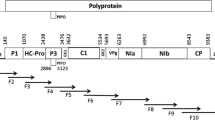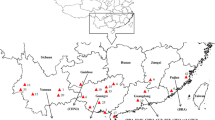Abstract
Sugarcane yellow leaf virus (SCYLV; genus Polerovirus, family Luteoviridae) is a recombinant virus associated with yellow leaf disease, a serious threat to sugarcane in China and worldwide. Among the nine known SCYLV genotypes existing worldwide, COL, HAW, REU, IND, CHN1, CHN2, BRA, CUB and PER, the last five have been reported in China. In this study, the complete genome sequences (5,880 nt) of GZ-GZ18 and HN-CP502 isolates from the Chinese provinces of Guizhou and Hainan, respectively, were cloned, sequenced and characterized. Phylogenetic analysis showed that, among 29 SCYLV isolates described worldwide, the two Chinese isolates clustered together into an independent clade based on the near-complete genome nucleotide (ORF0-ORF5) or amino acid sequences of individual genes, except for the MP protein (ORF4). We propose that the two isolates represent a novel genotype, CHN3, diverging from other genotypes by 1.7-13.6 % nucleotide differences in ORF0-ORF5, and 2.7-28.1 %, 1.8-20.4 %, 0.5-5.1 % and 2.7-15.9 % amino acid differences in P0 (ORF0), RdRp (RNA-dependent RNA polymerase) (ORF1+2), CP (coat protein) (ORF3) and RT (readthrough protein) (ORF3+5), respectively. CHN3 was closely related to the BRA, HAW and PER genotypes, differing by 1.7-3.8 % in the near-complete genome nucleotide sequence. Recombination analysis further identified CHN3 as a new recombinant strain, arising from the major parent CHN-HN1 and the minor parent CHN-GD-WY19. Recombination breakpoints were distributed mostly within the RdRp region in CHN3 and the four significant recombinant genotypes, IND, REU, CUB and BRA. Recombination is considered to contribute significantly to the evolution and emergence of such new SCYLV variants.



Similar content being viewed by others
References
Abu Ahmad Y, Royer M, Daugrois JH, Costet L, Lett JM, Victoria JI, Girard JC, Rott P (2006) Geographical distribution of four Sugarcane yellow leaf virus genotypes. Plant Dis 90:1156–1160
Chinnaraja C, Viswanathan R, Karuppaiah R, Bagyalakshmi K, Malathi P, Parameswari B (2013) Complete genome characterization of Sugarcane yellow leaf virus from India: evidence for RNA recombination. Eur J Plant Pathol 135:335–349
D’Arcy C, Domier L (2005) Luteoviridae. In: Fauquet CM, Mayo MA, Maniloff J, Desselberger U, Ball LA, Claude MF (eds) Virus taxonomy: VIIIth report of the international committee on taxonomy of viruses. Elsevier Academic Press, New York, pp 891–900
ElSayed AI, Boulila M, Komor E, Zhu YJ (2012) Putative recombination signature and significance of insertion/deletion events in the RNA-dependent RNA polymerase coding region of Sugarcane yellow leaf virus. Biochimie 94:1764–1772
ElSayed AI, Komor E (2012) Investigation of ORF0 as a sensitive alternative diagnostic segment to detect Sugarcane yellow leaf virus. J Gen Plant Pathol 78:207–216
ElSayed AI, Weig AR, Komor E (2011) Molecular characterization of Hawaiian Sugarcane yellow virus leaf genotypes and their phylogenetic relationship to strains from other sugarcane-growing countries. Eur J Plant Pathol 129:399–412
Gao S-J, Lin Y-H, Pan Y-B, Damaj MB, Wang Q-N, Mirkov TE, Chen R-K (2012) Molecular characterization and phylogenetic analysis of Sugarcane yellow leaf virus isolates from China. Virus Genes 45:340–349
Haenni AL (2008) Virus Evolution and Taxonomy. In: Roossinck MJ (ed) Plant virus evolution. Springer-Verlag, Berlin, pp 205–217
Huson DH, Bryant D (2006) Application of phylogenetic networks in evolutionary studies. Mol Bio Evol 23:254–267
Lian S, Lee JS, Cho WK, Yu J, Kim MK, Choi HS, Kim KH (2013) Phylogenetic and recombination analysis of tomato spotted wilt virus. PLoS ONE 8(5):e63380
Maia LG, Gonaclaves MC, Arruda P, Vega J (2000) Molecular evidence that Sugarcane yellow leaf virus (ScYLV) is a member of the Luteoviridae family. Arch Virol 45:1009–1019
Mangwende T, Wang ML, Borth W, Hu J, Moore PH, Mirkov TE, Albert HH (2009) The P0 gene of Sugarcane yellow leaf virus encodes an RNA silencing suppressor with unique activities. Virology 384:38–50
Martin DP, Lemey P, Lott M, Moulton V, Posada D, Lefeuvre P (2010) RDP3: a flexible and fast computer program for analyzing recombination. Bioinformatics 26:2462–2463
Moonan F, Mirkov TE (2002) Analyses of genotypic diversity among North, South, and Central American isolates of Sugarcane yellow leaf virus: evidence for Colombian origins and for intraspecific spatial phylogenetic variation. J Virol 76:1339–1348
Moonan F, Molina J, Mirkov TE (2000) Sugarcane yellow leaf virus: an emerging virus that has evolved by recombination between luteoviral and poleroviral ancestors. Virology 269:156–171
Pagán I, Holmes EC (2010) Long-term evolution of the Luteoviridae: time scale and mode of virus speciation. J Virol 84:6177–6187
Rott P, Comstock JC, Croft BJ, Kusalwong A, Saumtally S (2005) Advances and challenges in sugarcane pathology: a review of the 2003 Pathology Workshop. Proc Int Soc Sugar Cane Technol 25:607–614
Schenck S (1990) Yellow leaf syndrome-a new sugarcane disease. Hawaiian Sugar Planters Association Annual report 38–39
Smith GR, Borg Z, Lockhart BEL, Braithwaite KS, Gibbs MJ (2000) Sugarcane yellow leaf virus: a novel member of the Luteoviridae that probably arose by inter-species recombination. J Gen Virol 81:1865–1869
Tamura K, Dudley J, Nei M, Kumar S (2007) MEGA4: molecular evolutionary genetics analysis (MEGA) software version 4.0. Mol Biol Evol 24:1596–1599
Wang MQ, Xu DL, Li R, Zhou GH (2012) Genotype identification and genetic diversity of Sugarcane yellow leaf virus in China. Plant Pathol 61:986–993
Wang MQ, Zhou GH (2010) A near-complete genome sequence of a distinct isolate of Sugarcane yellow leaf virus from China, representing a sixth new genotype. Virus Genes 41:268–272
Worobey M, Holmes EC (1999) Evolutionary aspects of recombination in RNA viruses. J Gen Virol 80:2535–2543
Acknowledgments
This research was supported by an Earmark Fund from the China Agriculture Research System (CARS-20-2-4) and a grant from the National Natural Science Foundation of China (31170345). We are grateful to Dr. Jia-Ju Lu (Guizhou Subtropical Crop Institute, Xingyi, China) and Mr. Zhong-xing Huang (Guangzhou Sugarcane Industry Research Institute, Guangzhou, China) for supplying the sugarcane leaf samples.
Author information
Authors and Affiliations
Corresponding author
Electronic supplementary material
Below is the link to the electronic supplementary material.
Rights and permissions
About this article
Cite this article
Lin, YH., Gao, SJ., Damaj, M.B. et al. Genome characterization of sugarcane yellow leaf virus from China reveals a novel recombinant genotype. Arch Virol 159, 1421–1429 (2014). https://doi.org/10.1007/s00705-013-1957-3
Received:
Accepted:
Published:
Issue Date:
DOI: https://doi.org/10.1007/s00705-013-1957-3




